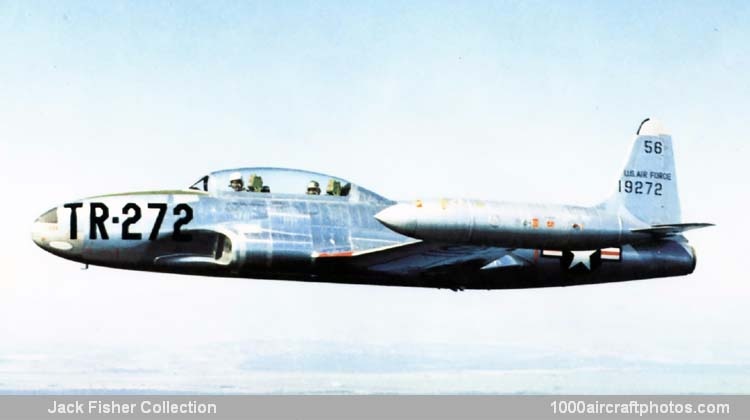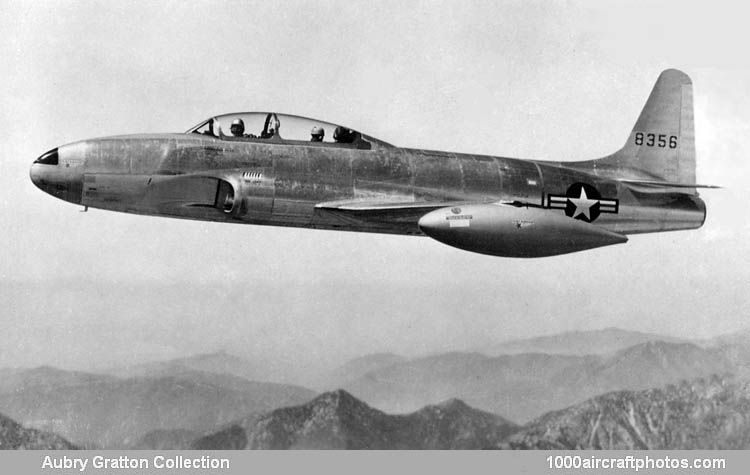05/31/2010. Remarks by
Johan Visschedijk: "Early in the development cycle of the P-80, Mac V.F. Short, vice-president in charge of military relations, identified the need for a two-seat training version and suggested that development of such a version be undertaken. However, his suggestion was not taken up until 1947 when the P-80s high accident rate pointed to the urgent need for a jet-transition trainer.
Gambling on its own funds, in May 1947 Lockheed assigned the designing of the Model 580 two-seat trainer to a team led by Don Palmer and three months later obtained Air Force authorization to modify a P-80C airframe to serve as the TP-80C prototype. To provide room for the instructor aft of the student Palmer revised the fuselage design by inserting a 38.6 in (98 cm) plug forward of the wing and a 12 in (30.5 cm) plug aft, and by reducing the fuselage fuel-tank capacity from 207 to 95 gal (784 to 360 l).
To offset this fuel reduction, nylon cells were installed in the wings instead of the P-80s self-sealing tank, to bring internal fuel capacity to 353 gal (1,336 l), as opposed to 425 gal (1,609 l) for the P-80C. As originally designed, the internal fuel capacity could be increased by the use of two standard 165 gal (625 l) drop tanks beneath the wing tips. This arrangement was retained for the early production aircraft but 230 gal (871 l) center line tip tanks were later adopted. The tandem ejector seats were housed beneath a clear canopy which was raised electrically or, in an emergency, manually. To conserve weight, the trainer's built-in armament was reduced to two 0.50 in (12.7 mm) machine guns.
Lockheed 580 TP-80C-LO (48-356) (
Aubry Gratton Collection)
The successful maiden flight of the first TP-80C-LO (48-356) was made by Tony LeVier on March 22, 1948, from Van Nuys Airport. Handling characteristics were found equal to those of the P-80C, itself an aircraft well liked by pilots, and operating speeds at comparable engine settings were slightly higher. During the spring of 1948, by which time an initial batch of twenty aircraft (s/n 48-356 to 48-375) had been ordered by the USAF, the TP-80C was sent on a tour of military air fields in the United States. The results of this tour were soon evident as production orders were quickly received for additional TF-80Cs (designation changed from TP-80Cs on 11 June, 1948, and finally to T-33A on 5 May, 1949).
The first production TF-80C was accepted by the Air Force in August 1948. Like other initial production aircraft, it was powered by a 4,600 lb (2,087 kg) thrust Allison J33-A-23; later production trainers were delivered with the 5,200 lb (2,359 kg) thrust J33-A-25 and most aircraft were later re-engined with the 5,400 lb (2,450 kg) thrust J33-A-35.
The production of all T-33 versions, including the TV-2 for the US Navy, were under Air Force contracts and covered a total of 5,691 Lockheed-built T-33A-1-LOs and T-33A-5-LOs in 28 batches ordered with funds from eleven successive Fiscal Years (28 in 1948; 144 in 1949; 140 in 1950; 1,970 in 1951; 847 in 1952; 1,361 in 1953; 145 in 1954; 286 in 1955; 256 in 1956; 240 in 1957; and 274 in 1958). In addition to the basic T-33A for the USAF there were the following T-33A versions:
AT-33A-LO: For delivery to smaller air forces in Latin America and Southeast Asia a small number of T-33As were fitted with underwing pylons and stubs to carry up to 2,000 lb (907 kg) of bombs or eight 5 in (12.7 cm) HVAR (High-Velocity Aircraft Rockets). In addition to their usual training role, the AT-33As could be used for weapons-delivery training and counter-insurgency operations. At least one aircraft was fitted with a gun package, housing twin 0.50 in (12.7 mm) machine guns, beneath each wing. Standard T-33As were frequently modified to a similar standard by their recipients.
DT-33A-LO: USAF T-33As modified for use as drone directors.
NT-33A-LO: When modified permanently for special tests, a number of T-33As were redesignated NT-33As. Among these one-off aircraft was 51-4120 which was successively used for tests by Lockheed, the Allison Division of General Motors, the USAF Wright Air Development Center, and the Flight Research Department of the Cornell Aeronautical Laboratory (later reorganized as the Calspan Corporation). With Calspan the aircraft was fitted with a larger-volume nose section from an F-94A to accommodate test equipment and computer electronics.
Used for variable-stability research and for simulating the flying qualities of a variety of aircraft then under development, this NT-33A was at various times fitted with alternative controls (wheel, stick, two-axis and three-axis side controller), 'fly-by-wire' system, modified tip tanks with electro-hydraulically-operated drag petals, and inflight-refueling probe. In 1980 Calspan was still using 51-4120 in a project sponsored jointly by the USAF and USN and known as Display Evaluation Flight Test (DEFT).
Two other NT-33As were 48-357 and 51-4263; 48-357, the second TF-80C, was used for ejector-seat trials and fitted with aft-focusing camera recording equipment on top of the nose and with an open rear cockpit; 51-4263 was modified by Lockheed to have twin fins and rudders at the ends of the tail plane instead of the standard single tail surfaces. The modified tail was at the time considered for the proposed TV-2 deck-landing trainer. Testing was not fully satisfactory and the new aircraft, the CL-245 (T2V-1 in the Navy), had conventional tail surfaces.
QT-33A: During the late seventies ex-USAF T-33As were modified as drones for use by the Navy at the Pacific Missile Test Center at Point Mugu, California, and the Naval Weapons Center at China Lake, California.
RT-33A-LO: Complementing the AT-33A armed-trainer version in the inventory of several smaller air forces, the RT-33A was a photographic-reconnaissance version with vertical and oblique camera installation in a nose of modified contour. Electronic and recording equipment was fitted in the rear cockpit, in the space normally occupied by the instructor. A total of eighty-five T-33As were modified to the RT-33A configuration and came from the USAF s/n batches 53-4886 to 53-6152 (75 aircraft) and 54-1522 to 54-1618 (10 aircraft)."

